外研版(2019)必修第一册Unit 6 At one with nature Using language Attributive Clauses 课件(共27张PPT)
文档属性
| 名称 | 外研版(2019)必修第一册Unit 6 At one with nature Using language Attributive Clauses 课件(共27张PPT) |  | |
| 格式 | pptx | ||
| 文件大小 | 10.9MB | ||
| 资源类型 | 教案 | ||
| 版本资源 | 外研版(2019) | ||
| 科目 | 英语 | ||
| 更新时间 | 2024-04-15 19:52:43 | ||
图片预览

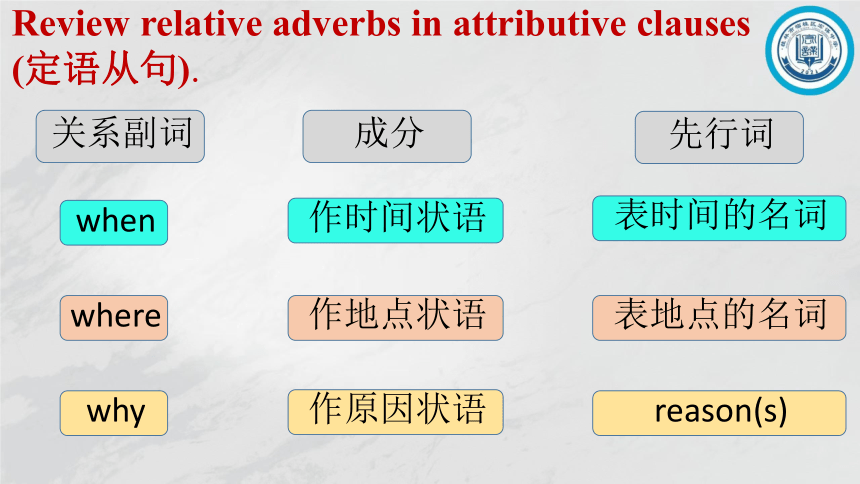
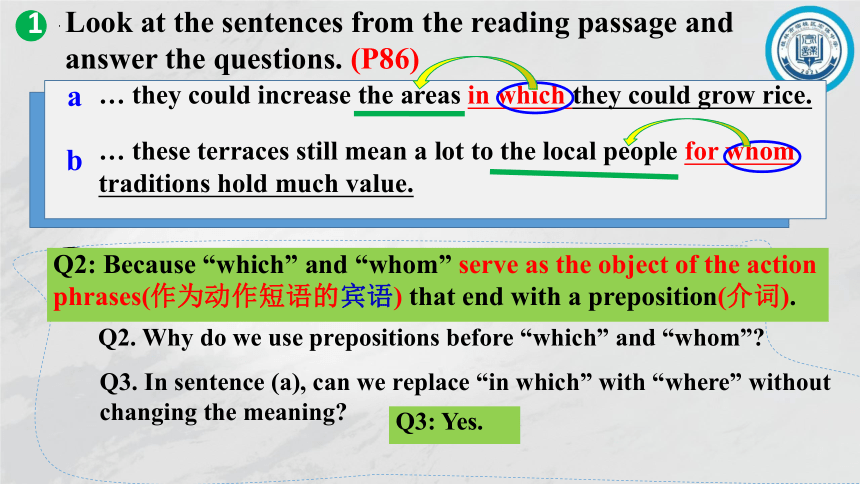
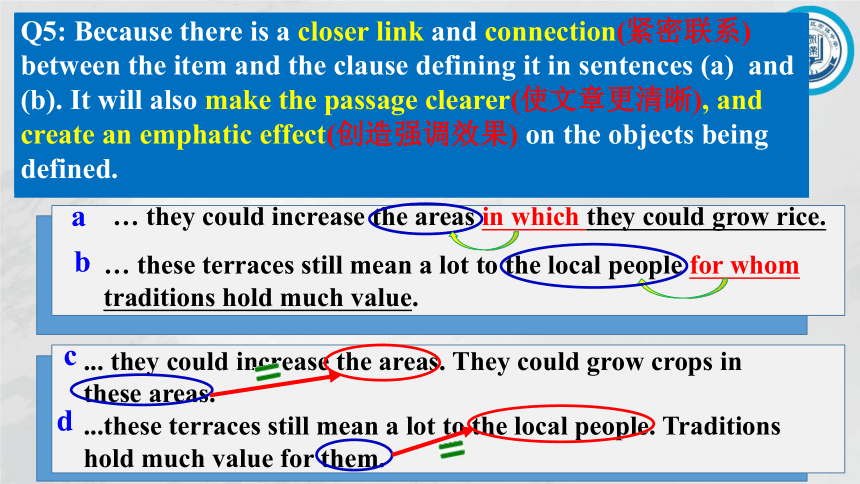

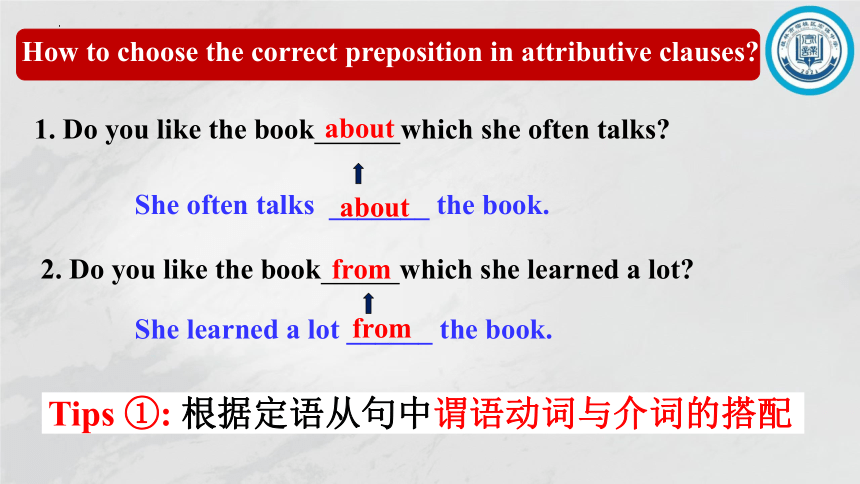

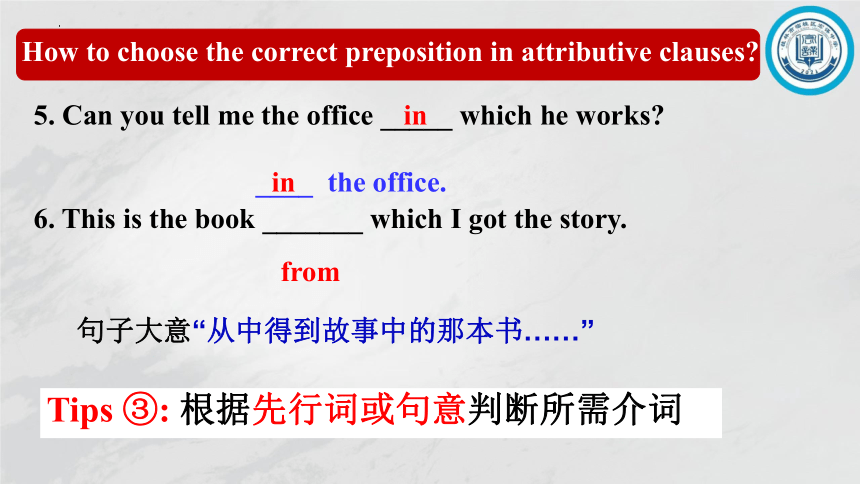
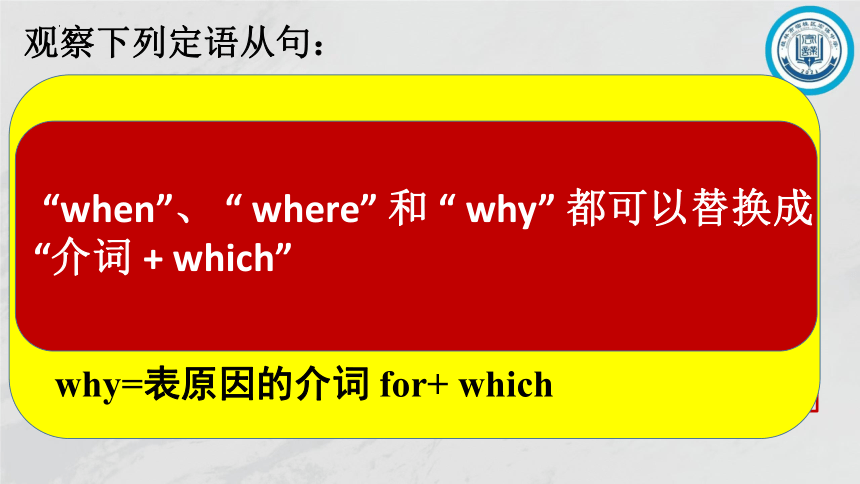
文档简介
(共27张PPT)
Unit 6 At One with Nature
Using language-Grammar
Attributive Clauses
Review relative adverbs in attributive clauses
(定语从句).
关系副词
成分
先行词
when
作时间状语
表时间的名词
where
作地点状语
表地点的名词
why
作原因状语
reason(s)
… they could increase the areas in which they could grow rice.
… these terraces still mean a lot to the local people for whom traditions hold much value.
a
b
Look at the sentences from the reading passage and answer the questions. (P86)
Q1. What do “which” and “whom” refer to in
each sentence
Q2. Why do we use prepositions before “which” and “whom”
Q2: Because “which” and “whom” serve as the object of the action phrases(作为动作短语的宾语) that end with a preposition(介词).
Q3: Yes.
1
Q3. In sentence (a), can we replace “in which” with “where” without changing the meaning
… they could increase the areas in which they could grow rice.
… these terraces still mean a lot to the local people for whom traditions hold much value.
a
b
... they could increase the areas. They could grow crops in these areas.
...these terraces still mean a lot to the local people. Traditions hold much value for them.
c
d
Compare and answer the questions.
4. What is the difference between the two groups of sentences
5. Why does the author choose to use sentences (a) and (b) in the reading passage
Q4: Sentences (a) and (b) both contain a clause defining a noun in the sentence(包含一个定义名词的从句).
Sentence (c) and (d) are constructed with a pair of simple sentences(由简单句构成), with one defining a noun in the other sentence(在另一个句子中定义名词) in each pair.
Q5: Because there is a closer link and connection(紧密联系) between the item and the clause defining it in sentences (a) and (b). It will also make the passage clearer(使文章更清晰), and create an emphatic effect(创造强调效果) on the objects being defined.
Structure of Attributive clauses
介词 +
关系代词
指人
指物
介词 + whom
介词 + which
a preposition+ whom/which
1. Do you like the book which she often talks
about
She often talks _______ the book.
about
Tips ①: 根据定语从句中谓语动词与介词的搭配
How to choose the correct preposition in attributive clauses
2. Do you like the book which she learned a lot
She learned a lot ______ the book.
from
from
3. This road will take me to the place ______ which I belong.
Tips ②: 根据定语从句中动词、形容词等构成的短语确定所需介词。
to
belong _____
4. He is a learned man _____ whom we are familiar.
be familiar _____
to
with
with
How to choose the correct preposition in attributive clauses
Tips ③: 根据先行词或句意判断所需介词
5. Can you tell me the office _____ which he works
6. This is the book _______ which I got the story.
____ the office.
句子大意“从中得到故事中的那本书……”
in
in
from
How to choose the correct preposition in attributive clauses
观察下列定语从句:
1. I’ll never forget the day when I joined the army.
2. This is the house where I lived two years ago.
3. Can you tell me the reason why you were late for school
when = ______ which
on
where =______ which
in
why = ______ which
for
= Can you tell me the reason for which you were late for school
= I’ll never forget the day on which I joined the army.
= This is the house in which I lived two years ago.
when=表时间的介词(in, at, during等)+which
where =表地点的介词(in, at, on, under等) +which;
why=表原因的介词 for+ which
“when”、 “ where” 和 “ why” 都可以替换成“介词 + which”
Conclusion: “介词+关系代词”引导的定语从句
1. 关系代词在定语从句中作介词的宾语
3. 如何选关系词:
Tips ①: 根据定语从句中谓语动词与介词的搭配
Tips ②: 根据定语从句中动词、形容词等构成的短语确定所需介词
Tips ③: 根据先行词或句意判断所需介词
2. 结构:关系代词指人 介词 + whom
关系代词指物 介词 + which
1. I met the child whom I looked after ten years ago.
2. I wanted to visit the house which my grandparents lived in.
Addition:
介词处于句尾时,句中的关系代词可以省略。
含有介词的动词固定短语在定语从句中一般不拆开, 在这种情况下,介词仍然放在后面,如 hear from, look after 等。
Connect the sentences with a preposition +
whom/which. (P86)
2
1. The Zhuang is an ethnic group. Its population is the largest of all ethnic groups in China.
The Zhuang is an ethnic group of which the population is the largest of all ethnic groups in China.
a group _____
of
2. Guangxi is a province. The Longji Rice Terraces
are located in it.
Guangxi is a province in which the Longji Rice
Terraces are located.
are located _____
in
3. I want to visit this cultural landscape. The title of UNESCO World Heritage Site was given to it in 2016.
I want to visit this cultural landscape to which the title of UNESCO World Heritage Site was given in 2016.
be given _____
to
联合国教科文组织
4. He is an expert on rice planting. The local Zhuang people have learnt a lot from him.
He is an expert on rice planting from whom the local Zhuang people have learnt a lot.
learn _____
from
Complete the passage with a preposition + whom / which. P87
3
from which
in which
Natural dyes come _______ the common natural source.
from
Colorful flowers are planted _____ the gardens.
in
for which
for whom
a priority for... 优先权
They perfer natural dyes ______ the reasons.
Caring for the environment is a priority _____ consumers.
for
for
Read the descriptions and match them to the pictures. (P87)
4
1 Located off the coast of Australia, the Great Barrier Reef is the biggest structure made by living organisms. You can explore the Great Barrier Reef by visiting an underwater observatory.
大堡礁
underwater observatory
海底观测站
2 Part of the Colorado River Basin, the Grand Canyon is a valley that is almost two kilometres deep.Tourists can stand on a narrow glass platform called the Skywalk to see the Grand Canyon.
科罗拉多大峡谷
3 Victoria Falls is the largest waterfall in the world. The local people call it “ the smoke that thunders”. The Victoria Falls Bridge connects the countries Zimbabwe and Zambia.
维多利亚瀑布
Victoria Falls Bridge
4 The English Channel separates England from France. These two countries are joined by the Channel Tunnel, a rail tunnel with a length of about 50 kilometres, most of which is under the sea.
英吉利海峡
English Channel
reef river basin canyon valley falls
waterfall channel tunnel sea
5
Complete the email with the words in the box. (P88)
Hi Jane,
I’m now back in the hotel after a fantastic day exploring Huangguoshu National Park. The park is most famous for its 1 ____________. Check out this video that I made – it shows the water falling into the deep 2 _______ below.
waterfall
valley
Next week we are flying to the Turpan 3 ________ in Xinjiang, which is famous for its sweet grapes. I’ve heard that grapes are dried in drying houses to make raisins. The walls of the houses have a lot of holes in them to allow wind to pass through. How clever! We are also going to ride camels, “the ships of the desert”. It sounds like I will be sailing on a(n) 4 ____________ of sand!
See you soon.
Emma
Basin
sea / ocean
Unit 6 At One with Nature
Using language-Grammar
Attributive Clauses
Review relative adverbs in attributive clauses
(定语从句).
关系副词
成分
先行词
when
作时间状语
表时间的名词
where
作地点状语
表地点的名词
why
作原因状语
reason(s)
… they could increase the areas in which they could grow rice.
… these terraces still mean a lot to the local people for whom traditions hold much value.
a
b
Look at the sentences from the reading passage and answer the questions. (P86)
Q1. What do “which” and “whom” refer to in
each sentence
Q2. Why do we use prepositions before “which” and “whom”
Q2: Because “which” and “whom” serve as the object of the action phrases(作为动作短语的宾语) that end with a preposition(介词).
Q3: Yes.
1
Q3. In sentence (a), can we replace “in which” with “where” without changing the meaning
… they could increase the areas in which they could grow rice.
… these terraces still mean a lot to the local people for whom traditions hold much value.
a
b
... they could increase the areas. They could grow crops in these areas.
...these terraces still mean a lot to the local people. Traditions hold much value for them.
c
d
Compare and answer the questions.
4. What is the difference between the two groups of sentences
5. Why does the author choose to use sentences (a) and (b) in the reading passage
Q4: Sentences (a) and (b) both contain a clause defining a noun in the sentence(包含一个定义名词的从句).
Sentence (c) and (d) are constructed with a pair of simple sentences(由简单句构成), with one defining a noun in the other sentence(在另一个句子中定义名词) in each pair.
Q5: Because there is a closer link and connection(紧密联系) between the item and the clause defining it in sentences (a) and (b). It will also make the passage clearer(使文章更清晰), and create an emphatic effect(创造强调效果) on the objects being defined.
Structure of Attributive clauses
介词 +
关系代词
指人
指物
介词 + whom
介词 + which
a preposition+ whom/which
1. Do you like the book which she often talks
about
She often talks _______ the book.
about
Tips ①: 根据定语从句中谓语动词与介词的搭配
How to choose the correct preposition in attributive clauses
2. Do you like the book which she learned a lot
She learned a lot ______ the book.
from
from
3. This road will take me to the place ______ which I belong.
Tips ②: 根据定语从句中动词、形容词等构成的短语确定所需介词。
to
belong _____
4. He is a learned man _____ whom we are familiar.
be familiar _____
to
with
with
How to choose the correct preposition in attributive clauses
Tips ③: 根据先行词或句意判断所需介词
5. Can you tell me the office _____ which he works
6. This is the book _______ which I got the story.
____ the office.
句子大意“从中得到故事中的那本书……”
in
in
from
How to choose the correct preposition in attributive clauses
观察下列定语从句:
1. I’ll never forget the day when I joined the army.
2. This is the house where I lived two years ago.
3. Can you tell me the reason why you were late for school
when = ______ which
on
where =______ which
in
why = ______ which
for
= Can you tell me the reason for which you were late for school
= I’ll never forget the day on which I joined the army.
= This is the house in which I lived two years ago.
when=表时间的介词(in, at, during等)+which
where =表地点的介词(in, at, on, under等) +which;
why=表原因的介词 for+ which
“when”、 “ where” 和 “ why” 都可以替换成“介词 + which”
Conclusion: “介词+关系代词”引导的定语从句
1. 关系代词在定语从句中作介词的宾语
3. 如何选关系词:
Tips ①: 根据定语从句中谓语动词与介词的搭配
Tips ②: 根据定语从句中动词、形容词等构成的短语确定所需介词
Tips ③: 根据先行词或句意判断所需介词
2. 结构:关系代词指人 介词 + whom
关系代词指物 介词 + which
1. I met the child whom I looked after ten years ago.
2. I wanted to visit the house which my grandparents lived in.
Addition:
介词处于句尾时,句中的关系代词可以省略。
含有介词的动词固定短语在定语从句中一般不拆开, 在这种情况下,介词仍然放在后面,如 hear from, look after 等。
Connect the sentences with a preposition +
whom/which. (P86)
2
1. The Zhuang is an ethnic group. Its population is the largest of all ethnic groups in China.
The Zhuang is an ethnic group of which the population is the largest of all ethnic groups in China.
a group _____
of
2. Guangxi is a province. The Longji Rice Terraces
are located in it.
Guangxi is a province in which the Longji Rice
Terraces are located.
are located _____
in
3. I want to visit this cultural landscape. The title of UNESCO World Heritage Site was given to it in 2016.
I want to visit this cultural landscape to which the title of UNESCO World Heritage Site was given in 2016.
be given _____
to
联合国教科文组织
4. He is an expert on rice planting. The local Zhuang people have learnt a lot from him.
He is an expert on rice planting from whom the local Zhuang people have learnt a lot.
learn _____
from
Complete the passage with a preposition + whom / which. P87
3
from which
in which
Natural dyes come _______ the common natural source.
from
Colorful flowers are planted _____ the gardens.
in
for which
for whom
a priority for... 优先权
They perfer natural dyes ______ the reasons.
Caring for the environment is a priority _____ consumers.
for
for
Read the descriptions and match them to the pictures. (P87)
4
1 Located off the coast of Australia, the Great Barrier Reef is the biggest structure made by living organisms. You can explore the Great Barrier Reef by visiting an underwater observatory.
大堡礁
underwater observatory
海底观测站
2 Part of the Colorado River Basin, the Grand Canyon is a valley that is almost two kilometres deep.Tourists can stand on a narrow glass platform called the Skywalk to see the Grand Canyon.
科罗拉多大峡谷
3 Victoria Falls is the largest waterfall in the world. The local people call it “ the smoke that thunders”. The Victoria Falls Bridge connects the countries Zimbabwe and Zambia.
维多利亚瀑布
Victoria Falls Bridge
4 The English Channel separates England from France. These two countries are joined by the Channel Tunnel, a rail tunnel with a length of about 50 kilometres, most of which is under the sea.
英吉利海峡
English Channel
reef river basin canyon valley falls
waterfall channel tunnel sea
5
Complete the email with the words in the box. (P88)
Hi Jane,
I’m now back in the hotel after a fantastic day exploring Huangguoshu National Park. The park is most famous for its 1 ____________. Check out this video that I made – it shows the water falling into the deep 2 _______ below.
waterfall
valley
Next week we are flying to the Turpan 3 ________ in Xinjiang, which is famous for its sweet grapes. I’ve heard that grapes are dried in drying houses to make raisins. The walls of the houses have a lot of holes in them to allow wind to pass through. How clever! We are also going to ride camels, “the ships of the desert”. It sounds like I will be sailing on a(n) 4 ____________ of sand!
See you soon.
Emma
Basin
sea / ocean
